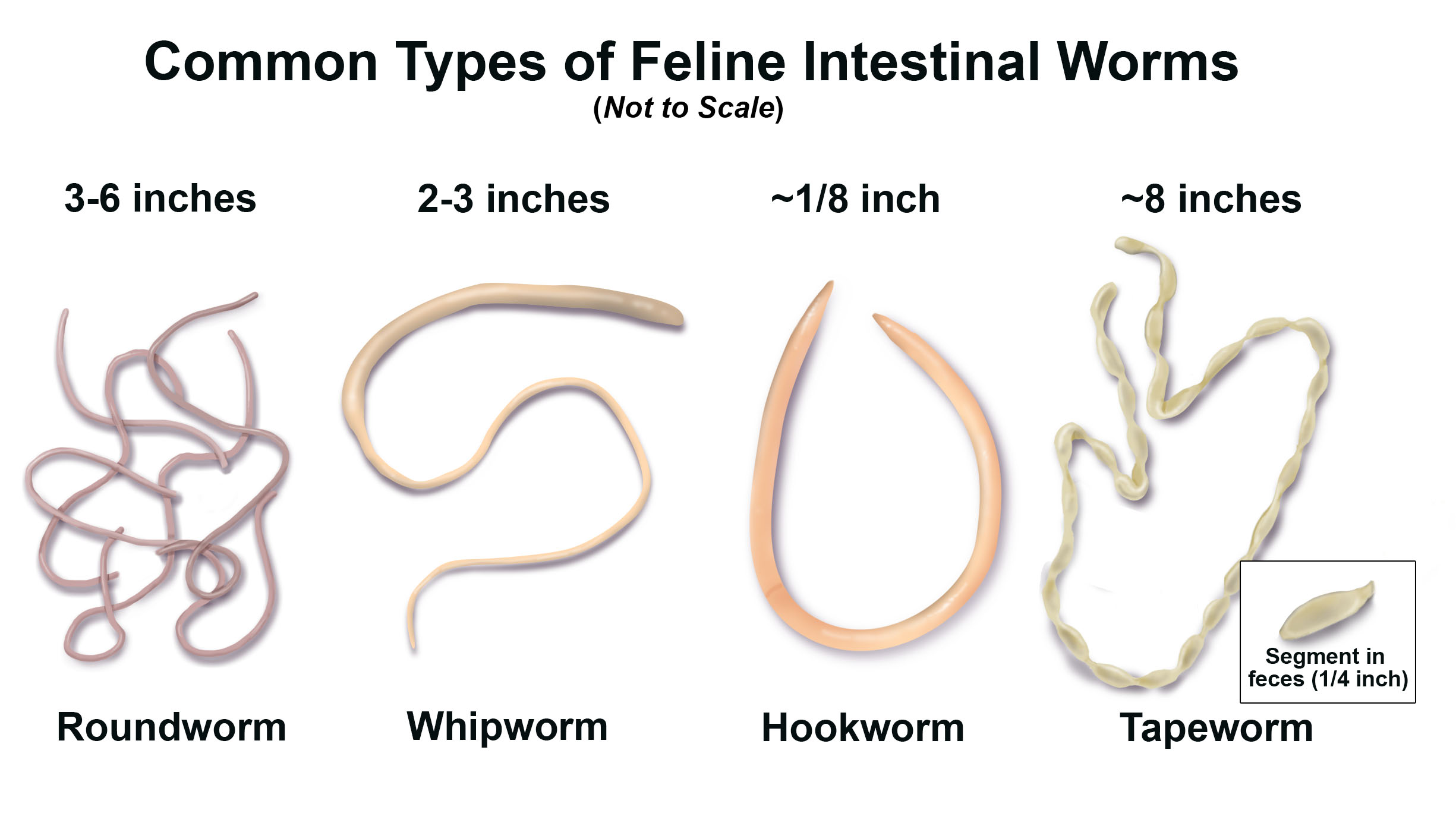Gastrointestinal Parasites of Cats
Gastrointestinal (GI) parasitism is a common problem in cats, with prevalence rates as high as 45% in some populations. These parasites can be wormlike or one-celled protozoan organisms. They usually cause fairly nonspecific symptoms, such as a dull coat, coughing, vomiting, diarrhea, mucousy or bloody feces, loss of appetite, pale mucous membranes, or a potbellied appearance. The vomiting, diarrhea, anemia, and dehydration caused by intestinal parasites can weaken a cat, making it more susceptible to viral and bacterial infections and other diseases. Importantly, some GI parasites of cats have the potential to infect humans.
Wormlike parasites
Roundworms (Toxascaris leonina and Toxocara cati) are the most common intestinal parasite of cats, affecting 25% to 75% of cats, with higher rates in kittens. Adult roundworms are three to five inches long, cream-colored, and live in the cat’s intestine, where they don’t attach to the intestinal walls and survive by eating food ingested by the host. Adult female worms produce fertile eggs that are passed in the infected cat’s feces. The eggs require several days to several weeks to develop into the infective larval stage.
Cats become infected with Toxocara cati by ingesting eggs or rodents (transport hosts) that have larvae in their tissues. Kittens can ingest larvae that pass through an infected queen’s milk, sometimes becoming infected soon after birth. Cats become infected with Toxascaris leonina by ingesting infective eggs in the environment or larvae in the tissues of rodents. This parasite cannot pass across the placenta or the queen’s milk, so cats less than two months of age rarely harbor Toxascaris leonina.
Roundworm infections are usually relatively benign, but affected kittens may show vomiting, diarrhea, constipation, or loss of appetite. If left untreated, roundworm infections may cause potentially life-threatening anemia (low red blood cell count) and, in extreme cases, stomach rupture, so infection should be taken seriously and treated aggressively. Infection is confirmed by the presence of parasite eggs during microscopic examination of the stool. Several medications treat roundworm infections effectively in cats, but owners can minimize the likelihood of infection by prohibiting hunting and reducing exposure to the feces of infected cats. Treating queens prior to breeding reduces the likelihood that the parasite will infect kittens. It is important to note that reinfection after successful treatment is relatively common.
Toxocara can infect people. When Toxocara larvae migrate through the tissues of people, they can cause damage to various organs and the eyes, called visceral larval migrans and ocular larval migrans, respectively. Although these diseases are rare, they can be quite serious, especially in young children. They can be easily avoided by preventing ingestion of Toxocara eggs from contaminated soil or hands.
Hookworms (Ancylostoma and Uncinaria) are slender, thread-like worms, less than a half-inch long, that live attached to the lining of the wall of the intestine, where they feed on the blood of the host. Because of their small size, they usually are not visible in the feces of infected cats. Hookworms are long-lived, capable of living as long as a cat. Less common than roundworm infections, the prevalence of feline hookworm infections varies considerably by geographic location in North America.
Adult cats usually become infected by larvae that penetrate their skin or that are ingested. Once the larvae enter the host, they migrate to the lungs and then to the intestines, where they develop into adult worms. It is uncertain whether cats can become infected by eating rodents with larvae in their tissues, or by ingesting an infected queen’s milk.
While mild cases of hookworm infection may cause diarrhea and weight loss, severe parasitism can cause anemia due to blood loss. In these cases, a cat’s feces will often appear black and tarry due to the presence of digested blood. If too much blood is lost, an affected cat may die without treatment. Fortunately, hookworms are easily diagnosed and treated. Good sanitation and daily cleaning of the litter box are keys to controlling hookworm infections.
Hookworm larvae (Ancylostoma) can penetrate human skin when people come in close contact with contaminated soil. As they migrate under the skin, these larvae can cause a skin condition called cutaneous larval migrans, characterized by itchiness, irritation, and long, linear, track-like lesions.
Tapeworms (cestodes) have long flattened bodies that resemble a tape or ribbon. Their small head is connected to a series of segments filled with eggs. The adult tapeworm lives in the small intestine with its head embedded in the mucous membrane lining of this part of the GI tract, absorbing nutrients eaten by the host. As the segments farthest from the head become fully mature, they break off and pass in the feces. These segments can be observed near the cat’s tail and rectum, or in the feces. The flat, quarter-inch-long segments resemble grains of rice that stretch and contract when fresh, or sesame seeds when dry.
Microscopic examination of fecal samples may not always reveal the presence of tapeworms because eggs only pass as a group in the segments. Although the discovery of tapeworm segments can alarm cat owners, tapeworm infections rarely cause significant disease in cats.
Cats usually become infected with tapeworms by ingesting infected fleas while grooming or by eating infected rodents. Fleas and rodents become infected by eating tapeworm eggs in the environment. Modern medications are highly successful at treating tapeworm infections, but reinfection is common. Controlling flea and rodent populations reduces the risk of tapeworm infection in cats.
Some tapeworm species that infect cats can cause disease in humans if eggs are accidentally ingested; but good hygiene virtually eliminates any risk of human infection.
Whipworms are an uncommon parasite of cats in the United States. Adult whipworms reside in the large intestine and usually do not cause serious disease, although heavy infestations may cause diarrhea.
Stomach Worms Ollanulus tricuspis and Physaloptera species are worms that inhabit the feline stomach. Ollanulus infections occur sporadically in the U. S. and are more common in free-roaming cats and those housed in multiple-cat facilities. Cats become infected by ingesting the parasite-laden vomit of another cat. Chronic vomiting and loss of appetite, along with weight loss and malnutrition may be seen, although some infected cats show no signs of disease. Diagnosis of Ollanulus infection can be difficult, and relies upon detecting parasite larvae in the vomit. Effective treatment is available, and avoiding exposure to cat vomit is the most effective way to control infection.
Physaloptera infections are even more rare than Ollanulus infections. Adult female worms attached to the stomach lining pass eggs that are eaten by an intermediate host, usually a cockroach or cricket. After developing within the intermediate host, the parasite causes infection when a cat ingests the insect or a transport host, such as a mouse, that has eaten an infected insect. Cats infected with Physaloptera may experience vomiting and loss of appetite. Diagnosis requires microscopic detection of parasite eggs in the stool, or seeing the parasite in the vomit. Effective treatment exists, and infection can be prevented by limiting exposure to intermediate and transport hosts.
Neither Ollanulus nor Physaloptera cause disease in humans.
Protozoan Parasites
Isospora sp. (coccidia) are microscopic one-celled organisms that cause coccidiosis. Virtually all cats become infected with Isospora felis during their life, usually by eating a cyst, a thick-walled, egg-like stage that is passed in the feces and matures in the soil. Cysts can be infective within six hours of being excreted in feces. Cats may also become infected by eating flies or cockroaches that carry Isospora cysts.
Isospora infections usually cause no problems in adult cats, but can cause significant disease in kittens, where the coccidia may destroy the lining of the intestine and cause mucousy diarrhea. Infected kittens may also experience vomiting or a decreased appetite. Serious infections may develop in crowded environments, but good sanitation and hygiene will help control coccidia. Accurate diagnosis relies upon demonstration of microscopic cysts in the feces. Isospora of cats cannot cause disease in humans.
Giardia are one-celled organisms that move with the help of whip-like tails and parasitize the small intestine of cats. Giardia infection, called giardiasis, occurs in less than 5% of cats, but rates can be much higher in some environments. Cats become infected by ingesting Giardia cysts in the feces of another infected animal, usually a littermate or chronic carrier cat. Giardiasis is more common in multiple-cat households and catteries, and the infection rate is greater in cats less than one year old.
Giardia cysts are very resistant to freezing and municipal water chlorination. After ingesting cysts, it takes five to 16 days before a cat will show signs. Signs of infection may include acute or chronic diarrhea, although the majority of Giardia-infected cats show no signs. They do, however, remain a source of infection to other cats, although several exposures may be required to transmit infection.
Diagnosis of giardiasis depends upon microscopic identification of cysts in the stool or identification of DNA or Giardia proteins in the stool using advanced molecular biological or antibody-based techniques. For accurate diagnosis, several fecal samples may need to be evaluated because cysts are not shed continuously. Effective medications can treat giardiasis in cats, but resistance is common. Elimination of Giardia infections from households of cats may be difficult and depends on proper treatment and sanitation.
It is uncertain whether species of Giardia that infect cats are contagious to humans or vice versa, although recent studies suggest the possibility of cat to human transmission. Careful hygiene will eliminate the risk of accidental ingestion of cysts.
Toxoplasma (For more detailed information on this parasite, see our Toxoplasmosis article) Cats are the definitive host for the Toxoplasma gondii organism. Infection with this one-celled parasite is fairly common, but rarely causes disease in cats. Cats become infected by eating any of the three infective stages of Toxoplasma; most commonly by eating tissue cysts in infected prey or in other raw meat. Toxoplasma multiplies in the small intestine and the oocysts are excreted in the feces after two to three weeks. These oocysts take approximately one to five days to become infective after being shed, highlighting the importance of daily cleaning of the litter box to control the spread of toxoplasmosis. Toxoplasmosis can be transmitted to humans, although most otherwise healthy people infected with this organism show few if any signs of disease. The exceptions to this are immunocompromised individuals and pregnant women, both of whom should be very careful to avoid exposure to infective Toxoplasma oocysts (see our article on Zoonotic Diseases).
Treatment
The treatment of gastrointestinal parasites often requires medication prescribed by a veterinarian. Whenever using medications, be sure to follow the provided directions carefully. Parasite reinfections are very common, but can be prevented. Parasite control begins with good sanitation procedures. This includes daily removal of feces, washing the litter box with a disinfectant, such as diluted household bleach, on a regular basis, avoiding overcrowded conditions, avoiding diets with raw meats, and controlling intermediate hosts like fleas, ticks, and rodents. Good parasite control is the key to a healthier cat.
Updated June 2018





